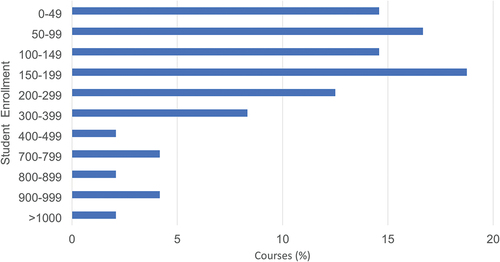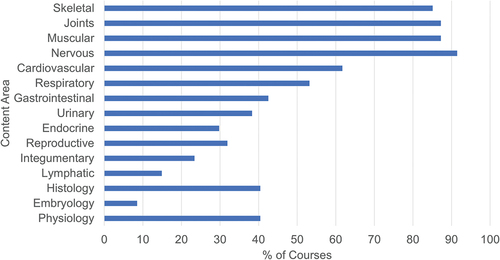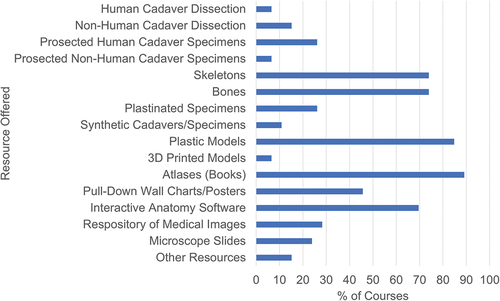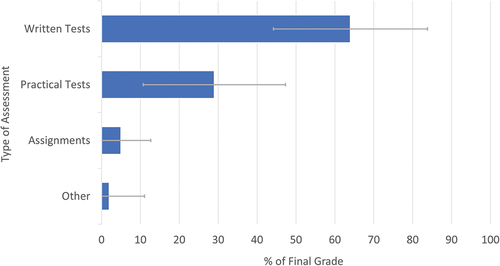ABSTRACT
Human anatomy is a key subject area within undergraduate kinesiology programs. However, literature detailing the course structures, available resources, and teaching approaches used to deliver anatomy education in kinesiology programs is lacking. The present study sought to address this deficit by surveying instructors in Canadian university and college kinesiology programs regarding the anatomy courses they offer. The median (IQR) reported enrollment across 48 courses (40% response rate) was 165 (155) students and the mean (±SD) student/instructor ratio was 20:1 (±9) for the laboratory/tutorial sessions. Systemic or regional approaches to teaching were utilized in 39.6% of courses each, while 20.8% used both. Weekly contact times for in-person lectures and laboratories were 2.7 (±0.5) hours and 1.9 (±0.8) hours, respectively. Written assessments accounted for 64% (±20) of students’ final grades, while practical tests accounted for 29% (±18). Joints and the skeletal, muscular, and nervous systems were the most covered units (>85% of courses). The most common resources available to students were atlases, plastic models, skeletons, and interactive software; human cadaver dissection was used in 7% of courses. Primary instructors for 95.5% of courses were permanent faculty/staff, but student assistants were utilized in half the courses, mostly for marking and laboratory activities. Overall, these results add considerably to the literature from allied health disciplines and fill a deficit in studies on the teaching methods and resources used for human anatomy education within Canadian undergraduate kinesiology programs. Accordingly, these findings may be used to inform curriculum design and best practices in anatomy course delivery.
Introduction
An undergraduate degree in kinesiology – the study of human body movement, function, and performance—directly prepares students for a variety of careers as a certified kinesiologist in roles such as rehabilitation specialists, ergonomists, and athletic trainers, or for continuing education in research and various healthcare professions, including physiotherapy, occupational therapy, chiropractic, and medicine (Elliott, Citation2007; Gledhill & Jamnik, Citation2009). To effectively prepare students for these careers, it is crucial that they have a strong background in human anatomy to visualize the three-dimensional relationships between tissues and structures within the body and to apply these concepts to understand how the body functions (Boone & Boone, Citation2003).
Undergraduate kinesiology programs are responsible for providing students with a solid foundation in anatomy, among other topics, such as biomechanics and ergonomics, physiology, and motor learning, to prepare them for many varied career paths (Elliott, Citation2007). However, it is difficult to evaluate studies that investigate the pedagogical approaches used for anatomy education in undergraduate kinesiology programs as data on the course structure, teaching methods, and available resources that are commonly used in these programs is extremely limited. Descriptions of specific anatomy courses in kinesiology programs (McWatt et al., Citation2021) and educational resources (Richardson et al., Citation2020) do exist in the literature. However, to the authors’ knowledge, the only study that has addressed any aspect of anatomy education within a larger scale kinesiology context was one investigation of whether a regional approach, that focuses on the relationships between all the organs and tissues of a specific region (i.e., neck), or a systemic approach, that focuses on all the organs and tissues of a particular body system at a time (i.e., cardiovascular system), was utilized by instructors in kinesiology programs at Canadian universities (Lafave & Tomkins-Lane, Citation2014). As a result, there is a large deficit in the literature regarding the design, structure, and delivery of human anatomy courses in undergraduate kinesiology programs, which limits the ability of educators in this field to compare practices on a broader scale within the discipline.
In-depth surveys conducted in various countries worldwide have investigated the approaches used to teach human anatomy within specific professional programs in health-related fields relevant to kinesiology, including medicine (Craig et al., Citation2010; Drake et al., Citation2014; Pan et al., Citation2020; Rockarts et al., Citation2020), chiropractic (Ball et al., Citation2012; Giuriato et al., Citation2020), and physiotherapy (Shead et al., Citation2018). The studies reporting on anatomy education in professional schools such as medicine and physiotherapy are not, however, directly transferrable to undergraduate kinesiology programs, as the availability and use of anatomy educational tools is often different between these programs of study due to discrepancies in resourcing (i.e., types of tools, laboratory space, and costs) and the number of students enrolled in these programs (Basset et al., Citation2018). Consequently, further investigation of the methods and tools commonly employed within Canadian kinesiology and related programs to teach human anatomy is warranted. Therefore, the purpose of this study was to document how human anatomy courses in Canadian university and college kinesiology programs are structured, as well as what resources, teaching approaches, and assessment approaches are utilized by instructors. The results of this study will help to inform the design and delivery of anatomy-based curricula in undergraduate kinesiology programs nationwide, which can be used by instructors when they consider implementing new methodologies and approaches within the courses they teach.
Materials and methods
Participants
The primary instructors (i.e., instructors of record) of anatomy courses in undergraduate kinesiology and kinesiology-related degree programs at all Canadian universities and colleges were invited to participate in this study. Kinesiology-related programs included closely associated disciplines that are known to be comparable in terms of the content delivered, and only differ with respect to the program name (e.g., human kinetics). Associated programs that do not focus on anatomical structures (e.g., sport management), or are clearly outside of the discipline of kinesiology, but also provide courses in human anatomy (e.g., science, medicine), were excluded from this study.
Publicly available e-mail addresses for the primary instructors at every university and college across Canada which had an undergraduate kinesiology or related program were retrieved from the institutions’ websites. In cases where instructor information was not available for a specific course, the Head of the relevant department was contacted and asked to forward the e-mail invitation to the primary instructor of each anatomy course offered within their department. Sessional instructors (e.g., if covering for a primary instructor on leave) were also asked to forward the survey to the primary instructor, if one existed, or to their Department Head, if they were not aware of who taught the course(s) normally. A reminder e-mail was sent to instructors who had not responded to the initial e-mail invitation after one month. Three authors of this paper participated in the study but did not see any results until they were anonymized.
The survey
The survey in this study was organized into five main sections: course demographics, approach and delivery, resources, assessment, and staff (Supplementary Appendix). To expand on the contribution of this study relative to comparable international studies and to add specific relevance to kinesiology courses, survey features and questions reported by Giuriato et al. (Citation2020) and Drake et al. (Citation2014) were expanded upon, and additional questions related to each section of the survey were included. To minimize any ambiguity in the questions and maximize the data sample that could be obtained, face and content validity were established for coherence, format, flow, and relevance by several authors of this paper, who are experienced anatomy educators in kinesiology programs, prior to contacting the potential participants.
Procedures
The survey was administered digitally using Qualtrics online software (2021, Qualtrics, Provo, UT) and participants were instructed to complete the survey for each human anatomy course they taught. The survey remained open for a three-month period from December 2021 until late February 2022 and participants were invited to enter a prize draw for a digital gift card at the end of the survey. Acknowledging the variety of unique responses to certain questions, the survey flow was designed to present relevant follow up questions to participants based on their previous responses.
Invitations to participate in the study were extended via an initial e-mail, which included a URL to the online survey. Consent to participate was indicated by the instructor when they clicked on the survey link. The study procedures were approved by the Research Ethics Boards of each of the three universities at which the authors are affiliated [University of Windsor Research Ethics Board (#20–162), the York University Office of Research Ethics (#e2020–337), and the Wilfrid Laurier University Research Ethics Board (#6641)].
Data analysis
Data analysis occurred in several steps. First, all responses were checked to ensure that they were associated with a unique course and that no duplicates were present. Next, all data were de-identified, including the institutions’ and instructors’ names. The response order was randomized, and each response was assigned a unique code. The data were then organized and analyzed in Microsoft Excel, version 16.0 (Microsoft Corp., Redmond, WA). Descriptive statistics [ranges, means, medians, ±standard deviations (SD), IQR, and frequencies] were determined for relevant variables. The normality of the data was assessed using the Shapiro-Wilk test. Additional qualitative responses that were offered as “other” responses for certain questions on the survey, were grouped into common themes and summarized in the results.
Results
Survey response
Responses were received from 33 instructors of 43 unique kinesiology courses offered at 25 Canadian universities (43.4% of professors, 52.1% of universities). Surveys from three instructors of five unique kinesiology courses from three Canadian colleges were also received (21.4% of professors and colleges). This provided an overall response rate of 40% of professors or department Chairs contacted and 45.2% of institutions. Overall, 18.8% of the responses were from British Columbia, 8.3% from Alberta, 4.2% from Saskatchewan, 4.2% from Manitoba, 41.7% from Ontario, 6.3% from Quebec, 2.1% from Newfoundland, 4.2% from Prince Edward Island, 10.4% from Nova Scotia, and 2.1% from New Brunswick. The number of responses for each question on the survey varied given that some questions were not applicable to all respondents based on their answers to previous questions. Two participants started the survey but did not complete it, though these data were still included. These discrepancies are highlighted throughout the results.
Course demographics
With respect to the experience of the instructors teaching each course, 41.7% (20) of the 48 courses had been taught five or fewer times by the instructor, 18.8% (9) between six and ten times, 16.7% (8) between 11 to 15 times, 10.4% (5) between 16 and 20 times, and 12.5% (6) had been taught more than 20 times by the instructor. In terms of enrollment, the median number of students in a course was 165 students (IQR 155), with a range of between 20 and 1400 students (). Regarding the level of the courses surveyed, there were 24 in first-year, 15 in second-year, seven in third-year, and two in fourth-year. Instructors reported that 62.5% (30) of 48 courses were open to students from departments outside of kinesiology, 83% (39) of 47 courses surveyed were mandatory for kinesiology students, and 77.1% (37) of 48 courses were run by the kinesiology department. Of note, most first-year and second-year courses were mandatory for students while third-year and fourth-year courses were optional. Furthermore, the mean student to instructor ratio in the laboratory or tutorial sessions associated with 42 courses was 20:1 (SD ±9; range 7:1–40:1); the other 6 of 48 courses do not have laboratory or tutorial sessions. Of the 48 courses, 70.1% (34), 45.8% (22), and 22.9% (11) are typically offered in the fall, winter, and summer semesters, respectively. Over 8% (4) of courses are offered over a full academic year, spanning both the fall and winter semesters. Note that Canadian universities and colleges typically follow a two-semester year with an elective summer term. The fall and winter terms usually run from September to December, and from January to April, respectively. A full-year course will typically run from September to April. If students elect to take additional courses over the summer, these will generally occur between May and August.
Pedagogical approach and content delivery
Systemic and regional pedagogical teaching approaches were used equally by instructors in 39.6% (19) of the 48 courses, while the remaining 10 courses utilized a mixture of both approaches. A systemic approach was most commonly used in first-year and second-year courses, while all third-year and fourth-year level courses used either a regional or mixed approach (). The skeletal, muscular, nervous systems and joints were the most covered content areas (). Many instructors reported integrating physiology to reinforce anatomical concepts to highlight the functions associated with specific anatomical structures or how they worked together.
Figure 2. Courses (% of 24 first-year, % of 15 second-year, % of 7 third-year, and % of 2 fourth-year) that use each approach to anatomy education.
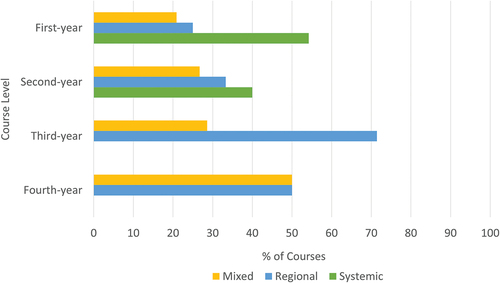
Over 91% (42) of the 46 courses were reported to use both face-to-face lectures and laboratories/tutorials. Synchronous and asynchronous online content delivery were normally (pre-Covid-19 pandemic) utilized in 26.1% (12) and 32.6% (15) of courses, respectively. The mean weekly contact time with students was 2.7 hours for face-to-face lectures and 1.9 hours for face-to-face laboratories (). In the laboratory sessions, demonstrations were reportedly employed by most courses while pre-readings, discussions, and reciprocal peer teaching were also commonly used (). Other laboratory teaching methods described by instructors included interactive laboratory modules, Process Oriented Guided Inquiry Labs, interactive quizzes, question and answer sessions, an online collaborative textbook, self-guided discovery, interactive games, group case-based learning, and hands-on models.
Figure 4. Mean (SD) weekly contact hours students experience using each content delivery method. F2F = face-to-face (in person). Note: 42 courses used F2F lectures; 42 courses used F2F labs/tutorials; 12 courses used synchronous online groups; 15 courses used asynchronous online individual sessions.
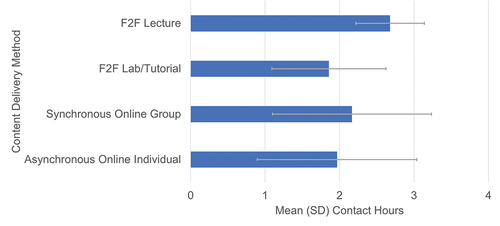
Table 1. Courses with labs (% of 42) that use each teaching method in the labs.
Resources
The most commonly available resources reported by instructors included atlases, plastic models, skeletons and bones, and interactive anatomy software, while cadaveric dissection and prosections (a pre-dissected cadaveric specimen) were rarely used (). Additional resources that were reported by instructors were patient videos, digital cadavers, dissection videos, modeling with clay, and a class visit to a cadaver laboratory. Courses with laboratory access (52.2%), used more dissections, prosections, and plastinated specimens, while those without access used more interactive software and plastic models ().
Table 2. Courses with (% of 22) or without (% of 24) access to an anatomy lab that offer each resource to students.
Assessment methods
Written exams (primarily multiple-choice questions) were the most often used type of assessment in the courses, followed by practical tests (primarily bellringers), and assignments (primarily worksheets) (). Additional types of assessments reported by instructors included interactive polling software (e.g., clickers) to engage students and weekly computer tests to provide regular feedback to students about their performance. Written exams were delivered on paper in 79.5% (35) of the 46 courses and on computers in 40% (18) of the courses. Other types of questions on written exams that were reported in addition to the original survey options (shown in ) included fill in the blank, labeling, and case studies. Further subtypes of assignments that were reported involved creating a learning tool to explain a topic, explaining sport skills using anatomy, group activities to draw structures and create questions, online practice quizzes, reflections on studying anatomy, and making an online collaborative textbook.
Table 3. Courses (% of 46 and total number of courses) that use each type of assessment and courses (% of 44 courses with written exams, % of 33 courses with practical exams, % of 19 courses with assignments) that use each assessment subtype.
The proportion of students’ grades accounted for by each assessment type was determined for 31 courses (i.e., only those where the total responses provided by instructors added up to 100%) (). On average, written exams accounted for nearly two-thirds of the students’ grades, while practical tests covered nearly one-third; assignments contributed the remainder.
Personnel
The primary instructors for 95.5% (43) of 45 courses were permanent staff, with 20 of those courses having more than one permanent staff member associated with the course (maximum six staff), while sessional staff were involved in six courses (maximum two staff). Graduate students supported approximately half (27) of the courses, with eight of those courses utilizing more than five students (and a maximum of 20). Undergraduate students were involved with 18 courses; nine of these courses had more than five students. Overall, there was a mean of nine personnel (range of 1–36 personnel) associated with each course. The survey also addressed the responsibilities of each type of personnel in the courses which included things such as lab demonstrating, marking, and proctoring (). Permanent staff were the most involved in all tasks compared to other personnel, though generally less in laboratory tasks where students were more involved in relative terms.
Table 4. Courses (%) using each type of personnel for course-related tasks.
Discussion
Pedagogical approach and content delivery
Systemic and regional approaches to structuring and delivering course content were both utilized to the same extent by instructors. However, a systemic approach was most used in introductory courses and a regional approach was more common in upper-level courses. One advantage of a systemic approach is that students can visualize and understand the physiology, histology, and pathology of one entire system at a time, which may be beneficial in introductory courses to establish anatomical concepts. An integrated anatomy and physiology curriculum and prosections are well suited to facilitating learning using a systemic approach (Pais & Moxham, Citation2013), though a pattern between integrated courses and the delivery approach used was not seen in this study. In comparison, a regional approach focuses students more on the three-dimensional relationships between structures and facilitates the application of their knowledge to real-world scenarios (Pais & Moxham, Citation2013). A regional approach would be beneficial in upper-year courses to prepare students for their future profession, such as a physiotherapist who would need to understand the impact that a lesion would have to structures within a specific anatomical area. Cadaveric dissections and multi-system prosections may be better methods to utilize in the laboratory when using a regional approach (Pais & Moxham, Citation2013). This is supported in the current study since roughly two thirds of the courses that used these resources also used a regional approach. While greater emphasis is currently being placed on developing stronger clinical reasoning skills in many kinesiology programs today, establishing a strong foundational knowledge base is still essential for success in these programs (Ataman & Ibey, Citation2022). Offering a mix of systemic and regional approaches to students across their degree program would expose them to the benefits of each and help to enhance student learning and skill development.
Courses which focus on the musculoskeletal and nervous systems in detail predominate, given their relevance to kinesiology – the study of human body movement, function, and performance – and should especially be incorporated into introductory courses. Two-semester courses may enable the delivery of additional systems, as would offering an upper-year course that covers systems to prepare students specifically for professional school programs. It was reported that some courses integrated physiological concepts, but these are typically offered over an entire academic year. Building content from one term to the next in two separate but related courses, is more the norm in the Canadian kinesiology higher education context.
Face-to-face lectures and laboratories were reported to have the highest average contact time of all course delivery types. Studies have shown that kinesiology (McWatt, Citation2021) and medical students (Choi-Lundberg et al., Citation2016; Davis et al., Citation2014) prefer face-to-face learning modalities (e.g., dissection) over virtual learning modalities (e.g., computer modules). Conclusions on the effectiveness of these learning approaches in medical education are varied (Afsharpour et al., Citation2018; Chrytas et al., Citation2019; Wilson et al., Citation2018). Given the restrictions related to content delivery that have been imposed by the recent pandemic, additional research should investigate the relative importance of face-to-face and virtual delivery methods for anatomy instruction and student learning in all allied health programs including kinesiology.
Resources
Just over half of the courses had access to an anatomy laboratory, which are typically located within either the kinesiology or science academic units, although no kinesiology course had access to a medical school anatomy laboratory. Courses that do not have access to an anatomy laboratory tended to use teaching resources such as interactive software, medical images, and plastic models more often, compared to courses with access to an anatomy laboratory that used dissections, prosections, and plastinated specimens more often. Dissection requires extensive instructional time to execute well, particularly for large classes. To provide quality laboratory experiences for students in large classes, multiple, small laboratory sections must be offered, which increases the need for materials, and increased attention to scheduling and staffing (Thomas, Citation2014; Wheeler & Van Mullem, Citation2021). However, increasing enrollments, limited access to laboratory materials, and the costs to store and maintain cadavers can also be prohibitive (Chumbley et al., Citation2021). This makes using them infeasible and impractical within most kinesiology programs in Canada. In comparison, resources such as plastic models, atlases, and interactive software can be used in a variety of settings and are more cost-effective, given the relatively large number of students typically served within these courses (Chumbley et al., Citation2021).
Overall, there is still much debate in the literature regarding the use of cadavers for anatomy education, with no formal consensus (Afsharpour et al., Citation2018; Chrytas et al., Citation2019; McWatt et al., Citation2021). A longitudinal analysis of anatomy teaching practices, their effectiveness, and how the resources that are available for teaching anatomy are utilized within kinesiology programs would help to identify trends in teaching innovation and potential factors that are influencing the delivery of anatomy education worldwide.
Assessment methods
Nearly all kinesiology anatomy courses in this study had written examinations (95.6%), most commonly with multiple choice and short answer questions. These written assessments accounted for 64% of the final grade, on average. Over 71% of the courses also had practical examinations, almost all of which were administered in a bellringer format, accounting for 29% of the final grade. Consequently, Canadian kinesiology courses emphasize written assessments of anatomical knowledge, but this does not come at the expense of practical assessments. Most courses still incorporate hands-on assessment practices, despite relatively large student enrollment on average across the country.
In a meta-analysis by Roach et al. (Citation2021), students’ performance on spatial tasks (i.e., practical identification assessments) was found to be positively correlated with spatial ability, although non-spatial tasks (i.e., multiple choice assessments) were not. As a result, Roach et al. (Citation2021) recommends incorporating both practical and written assessments so that students with lower spatial abilities are not disadvantaged while developing spatial skills that are associated with a greater understanding of anatomy. Implementing problem-based learning as appropriate for the level of study, may help to align with the recent shift in kinesiology education toward more clinical reasoning (Ataman & Ibey, Citation2022).
Personnel
Most of the kinesiology courses in this study employed full time staff and either graduate assistants, undergraduate assistants, or both. However, the range in the number and type of personnel utilized was considerable, which is consistent with the substantial difference in enrollment in courses across the country (ranged from 20 to 1400 students). A recent study by Basset et al. (Citation2018) found that student enrollment in kinesiology programs is increasing, though the number of staff and resources are not changing concomitantly. This has important implications for instructor burnout as they deal with increased workloads to teach more students and organize more laboratory sections (Thomas, Citation2014). To address instructor burnout, student involvement in courses could increase. For example, Evans and Cuffe (Citation2009) described a course that allows upper-year medical students to teach anatomy to early-year medical students as near-peer teachers. Upper-year students found that this program allowed them to reinforce their understanding of anatomical concepts, while early-year students reported an environment conducive to deeper learning of anatomical concepts.
Limitations
Data were obtained using a self-report survey. Although self-reports can be impacted by factors such as participant memory (Queiros et al., Citation2017) and social desirability bias (Bergen & Labonte, Citation2020), the questions asked of the instructors in this study were directly related to quantifiable details about the courses they teach (or taught recently) and not about their performance. The survey was reviewed for content and clarity by authors of this paper, all experienced anatomy educators, though external validity was not obtained. With respect to the sample, the response rate was more than 20% higher from university instructors compared to college instructors. This was partly because there are many fewer college kinesiology anatomy courses than university courses in Canada, and partly because Department Chairs were listed as the primary contact for most college programs and may not have forwarded the survey to current instructors. However, the data that were received overall represented a wide range of class sizes and programs from institutions across all ten provinces in the country. This study was completed during the COVID-19 pandemic at a time when many courses transitioned to online formats. While our survey asked specifically for data on courses prior to the pandemic, it is possible that some instructors reported data from pandemic era versions of the courses that may misrepresent how the courses are delivered traditionally.
Conclusions
This study offers data which fills a considerable gap in knowledge related to anatomy education in kinesiology programs, both in Canada and worldwide. To our knowledge, this study is the first of its kind to provide an in-depth investigation of the structure, resources, and teaching approaches used in kinesiology anatomy courses. This study also builds on previous work by Lafave and Tomkins-Lane (Citation2014) that investigated regional and systemic approaches to anatomy education in Canadian kinesiology programs and compliments a study of Canadian anatomical medical education by Rockarts et al. (Citation2020), one of the first surveys of anatomy education in Canadian medical schools independent of other countries. It is our expectation that anatomy instructors in kinesiology programs can use the data reported herein on common practices within higher education to inform the design and delivery of their courses, and to help them advocate for course reform at their institutions.
Supplemental Material
Download MS Word (23 KB)Disclosure statement
No potential conflict of interest was reported by the author(s).
Supplementary material
Supplemental data for this article can be accessed online at https://doi.org/10.1080/24711616.2024.2305890
References
- Afsharpour, S., Gonsalves, A., Hosek, R., & Partin, E. (2018). Analysis of immediate student outcomes following a change in gross anatomy laboratory teaching methodology. The Journal of Chiropractic Education, 32(2), 98–106. https://doi.org/10.7899/JCE-17-7
- Ataman, R., & Ibey, R. J. (2022). Applying clinical reasoning theories to kinesiology: Advancing the education of future healthcare professionals. International Journal of Kinesiology in Higher Education, 6(3), 137–150. https://doi.org/10.1080/24711616.2021.1881418
- Ball, J. J., Petrocco-Napuli, K. L., & Zumpano, M. P. (2012). An international survey of gross anatomy courses in chiropractic colleges. The Journal of Chiropractic Education, 26(2), 175–183. https://doi.org/10.7899/JCE-12-004
- Basset, D. R., Fairbrother, J. T., Panton, L. B., Martin, P. E., & Swartz, A. M. (2018). Undergraduate enrollment and faculty resources in kinesiology at selected U.S. public universities: 2008-2017. Kinesiology Review (Champaign, Ill), 7(4), 286–294. https://doi.org/10.1123/kr.2018-0043
- Bergen, N., & Labonte, R. (2020). “Everything is perfect, and we have no problems”: Detecting and limiting social desirability bias in qualitative research. Qualitative Health Research, 30(5), 783–792. https://doi.org/10.1177/1049732319889354
- Boone, T., & Boone, W. T., Jr. (2003). Why teach anatomy? Professionalization of Exercise Physiology Online, 6(3). https://www.asep.org/asep/asep/WhyTeachAnatomy.html
- Choi-Lundberg, D. L., Low, T. F., Patman, P., Turner, P., & Sinha, S. N. (2016). Medical student preferences for self-directed study resources in gross anatomy. Anatomical Sciences Education, 9(2), 150–160. https://doi.org/10.1002/ase.1549
- Chrytas, D., Piagkou, M., Johnson, E. O., Tsakotos, G., Mazarakis, A., Babis, G. C., Nikolaou, V. S., Kaseta, M., & Natis, K. (2019). Outcomes of the use of plastination in anatomy education: Current evidence. Surgical and Radiologic Anatomy, 41(10), 1181–1186. https://doi.org/10.1007/s00276-019-02270-3
- Chumbley, S. D., Devaraj, V. S., & Mattick, K. (2021). An approach to economic evaluation in undergraduate anatomy education. Anatomical Sciences Education, 14(2), 171–183. https://doi.org/10.1002/ase.2008
- Craig, S., Tait, N., Boers, D., & McAndrew, D. (2010). Review of anatomy education in Australian and New Zealand medical schools. ANZ Journal of Surgery, 80(4), 212–216. https://doi.org/10.1111/j.1445-2197.2010.05241.x
- Davis, C. R., Bates, A. S., Ellis, H., & Roberts, A. M. (2014). Human anatomy: Let the students tell us how to teach. Anatomical Sciences Education, 7(4), 262–272. https://doi.org/10.1002/ase.1424
- Drake, R. L., McBride, J. M., & Pawlina, W. (2014). An update on the status of anatomy sciences education in United States medical schools. Anatomical Sciences Education, 7(4), 321–325. https://doi.org/10.1002/ase.1468
- Elliott, D. (2007). Forty years of kinesiology: A Canadian perspective. Quest (National Association for Kinesiology in Higher Education), 59(1), 154–162. https://doi.org/10.1080/00336297.2007.10483544
- Evans, D. J., & Cuffe, T. (2009). Near-peer teaching in anatomy: An approach for deeper learning. Anatomical Sciences Education, 2(5), 227–233. https://doi.org/10.1002/ase.110
- Giuriato, R., Strkalj, G., Meyer, A., & Pather, N. (2020). Anatomical sciences in chiropractic education: A survey of chiropractic programs in Australia. Anatomical Sciences Education, 13(1), 37–47. https://doi.org/10.1002/ase.1871
- Gledhill, N., & Jamnik, V. R. (2009). Careers opportunities for exercise science/kinesiology graduates. The Health & Fitness Journal of Canada, 2(1), 25–28. https://doi.org/10.14288/hfjc.v2i1.24
- Lafave, M. R., & Tomkins-Lane, C. C. (2014). Survey of Canadian human anatomy courses in kinesiology and physical education. European Journal of Anatomy, 18(3), 199–204.
- McWatt, S. C. (2021). Responding to Covid‐19: A thematic analysis of students’ perspectives on modified learning activities during an emergency transition to remote human anatomy education. Anatomical Sciences Education, 14(6), 721–738. https://doi.org/10.1002/ase.2136
- McWatt, S. C., Newton, G. S., Umphrey, G. J., & Jadeski, L. C. (2021). Dissection versus prosection: A comparative assessment of the course experiences, approaches to learning, and academic performance of non-medical undergraduate students in human anatomy. Anatomical Sciences Education, 14(2), 184–200. https://doi.org/10.1002/ase.1993
- Pais, D., & Moxham, B. J. (2013). Should gross anatomy be taught systemically or regionally? European Journal of Anatomy, 17(1), 43–47.
- Pan, S. Q., Chan, L. K., Yan, Y., & Yang, X. (2020). Survey of gross anatomy education in China: The past and the present. Anatomical Sciences Education, 13(3), 390–400. https://doi.org/10.1002/ase.1952
- Queiros, A., Faria, D., & Almeida, F. (2017). Strengths and limitations of qualitative and quantitative research methods. European Journal of Education Studies, 3(9), 369–387. https://doi.org/10.5281/zenodo.887089
- Richardson, N. S., Zwambag, D., McFall, K., Andrews, D. M., & Gregory, D. E. (2020). Exploring the utility and student perceptions of synthetic cadavers in an undergraduate human anatomy course. Anatomical Sciences Education, 14(5), 605–614. https://doi.org/10.1002/ase.2024
- Roach, V. A., Mi, M., Mussell, J., Van Nuland, S. E., Lufler, R. S., DeVeau, K. M., Dunham, S. M., Husmann, P., Herriott, H. L., Edwards, D. N., Doubleday, A. F., Wilson, B. M., & Wilson, A. B. (2021). Correlating spatial ability with anatomy assessment performance: A meta-analysis. Anatomical Sciences Education, 14(3), 317–329. https://doi.org/10.1002/ase.2029
- Rockarts, J., Brewer-Deluce, D., Shali, A., Mohialdin, V., & Wainman, B. (2020). National survey on Canadian undergraduate medical programs: The decline of the anatomical sciences in Canadian medical education. Anatomical Sciences Education, 13(3), 381–389. https://doi.org/10.1002/ase.1960
- Shead, D. A., Roos, R., Oliver, B., & Ihunwo, A. (2018). Gross anatomy education for South African undergraduate physiotherapy students. Anatomical Sciences Education, 11(6), 554–564. https://doi.org/10.1002/ase.1763
- Thomas, J. R. (2014). The public face of kinesiology in the 21st century. Quest (National Association for Kinesiology in Higher Education), 66(3), 313–321. https://doi.org/10.1080/00336297.2014.918894
- Wheeler, W., & Van Mullem, H. (2021). High-impact educational practices in kinesiology: Examples of curricular advancements to prepare students for the future of work. Kinesiology Review (Champaign, Ill), 10(4), 419–427. https://doi.org/10.1123/kr.2021-0047
- Wilson, A. B., Miller, C. H., Klien, B. A., Taylor, M. A., Goodwin, M., Boyle, E. K., Brown, K., Hoppe, C., & Lazarus, M. (2018). A meta-analysis of anatomy laboratory pedagogies. Clinical Anatomy (New York, NY), 31(1), 122–133. https://doi.org/10.1002/ca.22934


